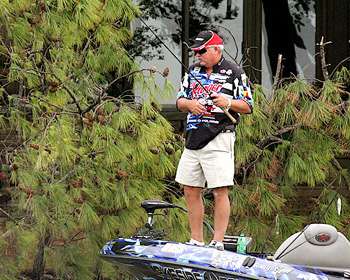
If you've ever fished with a jig, you've most likely had a bass "come unbuttoned" before it reaches the boat. Most often, anglers will utter the phrase "it just didn't get the hook."
Elite Series pro and veteran Oklahoma angler Tommy Biffle contends that it shouldn't be that way at all. Of course you're going to lose a fish or two, but Biffle has a near flawless hooking ratio on his bait of choice — the bass jig. "I just feel like when I have a jig on the end of my line and one bites it, I'm going to get it in the boat," he states.
To improve the hooking ratio on his jig, Biffle makes a key adjustment to ensure that the odds are more in his favor. "Out of the package, I will always cut the weedguard off right at the point of the hook," Biffle explains. "I'll fan the guard just to figure out where the point of the hook will be and cut it off right there. When I run my finger across the weedguard, I want the hook to be able to stick me."
Regardless of the situation, Biffle gets his scissors out each time he ties a new jig onto his line. "I cut every one of the brushguards after taking them out of the package," Biffle admits. "If you find that you're getting hung up quite a bit, all you have to do is press the guard forward a little bit, and it will protect the hook enough to keep from getting hung up quite so much." While fanning the weedguard will certainly limit most snags, he urges anglers to avoid doing so unless it's absolutely needed.
"I try to leave the weedguard in pretty much the position it's in when I get it out of the box," Biffle maintains. "If you cut that guard where the end of the hook is, you won't generally have to mess with fanning it out." Lure manufacturers use various densities in their weedguard composition. For best results, Biffle uses the touch test. "I prefer a weedguard that's between medium and soft," he says. "I want the guard to be soft enough that when I run my finger down it, I can feel the hook. Otherwise, I just feel like I'm going to be missing too many bites."
While Biffle has earned the reputation as a shallow water jig specialist, there are occasions on the Elite Series trail where shallow water isn't an option. In these situations cutting the weedguard flush with the hook point might not be enough.
"If I'm casting a jig to deep water, I'll go one step further and actually thin the weedguard out," Biffle explains. "I'll always have some kind of weedguard there, but when using lighter line in deeper water, I want that hook more exposed than when I'm flipping with it."
Along with weedguard density, lure manufacturers also offer color variations on the bristles. Color isn't an issue to Biffle. "I don't really think the color of the weedguard makes any difference," he points out. "Some manufacturers make a white guard, while others make it black. The fish are going to be keying on the bulk or profile of the jig itself — not the weedguard."
By taking a little time in preparing the jig for action before sending it into battle, Biffle is confident that anglers will catch more bass. Unfortunately, he admits that failure to do so is a pattern he's seen repeated over and over. "The biggest mistake I see guys making when I'm fishing with them is that they'll pull the jig out of the package and just tie it on without doing anything to it. There are a lot of things you can and should do to a jig that will help you catch more bass."
(Provided exclusively to BASS Insider by Z3 Media)




